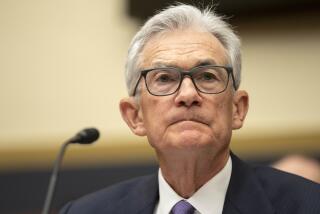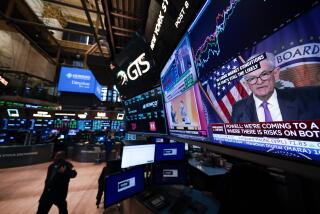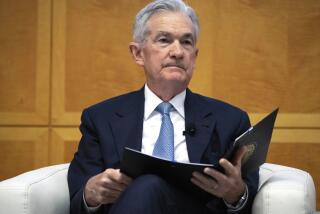Fed chief mum on next move
- Share via
BERLIN — Federal Reserve Chairman Ben S. Bernanke on Tuesday offered financial markets scant guidance on where U.S. interest rates may be heading in a speech in which he said the U.S. current-account gap was unsustainable.
“The large U.S. current-account deficit cannot persist indefinitely because the ability of the United States to make debt-service payments and the willingness of foreigners to hold U.S. assets in their portfolios are both limited,” he said at the Berlin-Brandenburg Academy of Sciences.
Bernanke, who also said U.S. external debts seemed not to be an undue burden at present, did not discuss the outlook for the U.S. economy or monetary policy, leaving intact expectations the Fed would cut interest rates at a meeting next Tuesday, perhaps by as much as a half-percentage point.
His largely academic remarks came days after the government reported that the U.S. economy shed 4,000 nonfarm jobs in August, the first drop in four years and a possible sign market turbulence and credit tightness were taking their toll on the broader economy.
The U.S. central bank has held the benchmark federal funds rate, which governs overnight lending between banks, at 5.25% since June of last year, although it has taken other steps, including lowering the discount rate it charges on direct loans to banks, to counter financial market stress.
Based on interest-rate futures contracts, markets appear to be looking for the Fed to cut the overnight rate by three-quarters of a point, if not more, by year end.
A range of Fed speakers on Monday offered varying views on the degree to which risks had risen in recent weeks, a debate Bernanke did not join.
Bernanke said that if the U.S. current-account gap was to persist at current levels, foreign investors would eventually have enough of dollar assets. It would be difficult for the United States to finance its debt at a reasonable cost at that point, he said.
Meanwhile, the global savings glut -- flows of capital from emerging economies into established economies, particularly the United States -- remains in place, Bernanke said. He has argued that the global savings glut is one reason long-term interest rates have remained low.
At the same time, other factors besides the balance between saving and investment affect long-term interest rates, Bernanke said. These include supply of and demand for long-term securities and changing sentiment about the risks embedded in long-term securities, he added.
With time, the savings glut should dissipate as emerging economies attract more investment and real interest rates should rise, he said. That said, other factors could influence interest rates as well, the Fed chairman added.
Economic growth in developed economies in recent years has raised demand for saving and contributed to rising real interest rates, he said.
Also, term premiums have increased recently from “unsustainably” low levels in part because of recent market volatility, he added.
More to Read
Inside the business of entertainment
The Wide Shot brings you news, analysis and insights on everything from streaming wars to production — and what it all means for the future.
You may occasionally receive promotional content from the Los Angeles Times.










